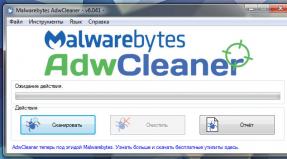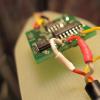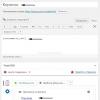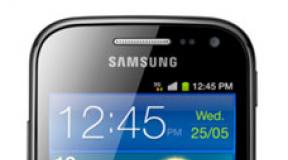How to make hidden folders. How to make files visible? How to hide folders
By default in Windows 7, to prevent any changes to the system folders inexperienced users, all important folders are hidden. But sometimes there is a need to make them visible. For example, virus software usually settles in hidden folders.
There are two ways you can make all folders open.
How to open hidden folders in Windows 7 - method No. 1
- Go to the Start menu and select Control Panel.
- There we find “Folder Options”.
- In the window that appears, go to the “View” tab.
- Here, in the “Advanced Settings” menu, use the mouse or scroll bar to go down to the very bottom of the menu.
- Activate the checkbox switch next to the “Show hidden files, folders and drives” option.
- Press the “OK” button or the Enter key on the keyboard.
Everything, all hidden folders and files will appear on the computer.
How to open hidden folders in Windows 7 - method No. 2
This method is even simpler than the previous one.
- Being in any folder or even just in “Computer”, in the left top corner, immediately below the address bar, click “Arrange”.
- In the submenu that appears, select “Folder and Search Options.”
- Here again we go to the “Folder Options” window and go to the “View” tab.
- And also switch to “Show hidden files, folders and drives”.
- And click OK.


It's very easy to check whether hidden folders have appeared. We go, for example, to “My Computer” in the Program Files folder, and there, along with regular folders, you can notice folders that have been hidden. They look sort of translucent.
Thus, there are two ways to open hidden folders in Windows 7. Both are simple and accessible. Even a novice user can handle them.
By default, the ability to see hidden files is disabled in any version of Windows. This is necessary so that inexperienced “dummies” do not accidentally delete anything and disrupt the operation of the OS. The solution is quite logical, since these folders are rarely needed. And even then - only to a few users. But sometimes there is a need to look at hidden files.
For example, during Windows optimization and garbage cleaning. Many programs ( Microsoft Word, Skype) create hidden files during operation. Over time, they become unnecessary, but are stored on disk and take up extra space.
Very often gamers need to enable hidden folders and files. After all, they are where saves from many games are stored.
Also, displaying hidden files is required by users who want to hide documents on a flash drive, but do not yet know how to find them later. In general, there are a lot of reasons.
Let me immediately note that in different Windows versions This setting is done in different ways. Although some methods may be the same. Therefore, below are several instructions on how to enable hidden files in all Windows - “seven”, “eight”, “ten” and XP. Plus given universal method, running on all OS.

If you need to disable their display, then in the same window, check the box “Do not show...”.
Second way:
- Go to Start, open Control Panel and click on the Folder Options shortcut.
- Select the “View” section, scroll the slider down and activate the “Show...” item.
- Save your changes by clicking Apply.
And the third way:
- Open any folder you like.
- Click Alt button- a menu like this will appear.
- Click Tools – Folder Options.
- A familiar window will open: to enable showing hidden files, go to the “View” tab and check the “Show...” checkbox.
As you can see, there is nothing complicated here. Choose any method that suits you best and use it at the right time.
When you enable viewing of hidden files in Windows 7 using any of the methods described above, they will be visible everywhere. Including on a flash drive. You just need to connect it to your PC or laptop - and you will see the hidden folders (provided that they are there). The same applies to an external HDD.
We've sorted out the "seven", now let's move on to the "eight".
How to enable hidden files in Windows 8?
There are also 3 options to choose from. The first two are described above in the instructions for Windows 7. That is, you can enable hidden files in Windows 8 by entering the control folders command. Or by selecting the “Folder Options” shortcut in the Control Panel.
But there is another way to show hidden files in Windows 8:
- Open any folder you like.
- Select the "View" section.
- Click on “Show or hide”, and then check the “Hidden elements” checkbox.

Ready. And not only in the current folder, but also in others. The same methods will help display hidden files on a flash drive or external HDD disk– you just need to connect them to your computer or laptop.
The last method, which works on Windows 8, is also suitable for the “ten”
To enable hidden files in Windows 10:
- Open any folder.
- Select the "View" section.
- Check the "Hidden Elements" box.

After this you will be able to see hidden folders and documents in any section hard drive or on a flash drive (it must be connected to the PC).
If you want to hide the folders again, uncheck this box.
There is also another way to enable the display of hidden files in Windows 10:


Ready. Now you can open any hidden files on Windows 10. As you can see, the methods on different versions of the OS are quite similar, but differ in minor nuances.
Not many users use Piggy today, but we’ll still consider it. You can view hidden files in XP like this:


That's it - now you can open or delete hidden folders and documents.
If you don’t want to understand the differences between different versions of Windows, you can use the universal method
In this case, you just need to install file manager Total Commander(download link). The program sees hidden documents and works on all Windows.
How to see hidden files in Total Commander? To do this you need to do the following:


Now all folders and documents in Total Commander will be visible. And you don’t even have to go to the Windows settings and change folder display options.
Need to see hidden documents? Launch Total Commander and go to the desired hard section disk. Or connect the USB flash drive and then open it through this file manager.
As you can see, all ingenious is simple. Now you know how to show hidden files and make them visible. And if necessary, you can easily find them. My only advice: if you find any unfamiliar folders, do not delete them. After all, they may contain important system files, the removal of which will break Windows.
Hiding folders and files from viewing in Windows 7 is a mechanism for protecting against access to particularly important data. It is used both to protect information from accidental and intentional changes, and to store confidential user information. It is also customary to hide some service files and folders so that they do not spoil appearance desktop and did not “clutter up” other directories.
Sometimes folders that should be visible are hidden. Most often this happens due to viruses that use this opportunity to hide more securely. And in some cases, this is done by the users themselves by changing the attributes of the object.
How to open hidden directories in Windows 7 Explorer?
If there are no obstacles (especially viruses) to gaining access to hidden directories, they can be opened in two ways:
- through the control panel applet “Folder Options”;
- through the “Arrange” folder menu.
Option using control panel
- Launch Control Panel.

- Click the “Design and Personalization” group.

- Find “Folder Options” and click the “Show hidden files and folders” link under it.

- In the next window, find in the list additional parameters “Hidden files and folders” and check the box next to “Show”. Click OK.

Folders with the “Hidden” attribute in their properties will become visible. IN Windows Explorer 7 they will have an unusual, translucent appearance.

Option using the “Arrange” menu
- Open any folder and click the “Arrange” button in the top menu.

- Select “Folder and Search Options” from the list.

- Go to the View tab in the Options window.

Further actions are the same as in the option using the control panel.
How to make hidden folders visible using Total Commander?
The Total Commander file manager, like Windows 7 Explorer, may or may not display hidden folders. If displayed, such objects are marked with a red exclamation mark.

If you do not see any such folders in the directory tree, then their display is turned off.
In order for Total Commander to show invisible objects, you need to open the “Configuration” menu and click “Settings”.

In the settings, you need to expand the “Panel Contents” category and check the “Show hidden/system files” checkbox. After that, click on the “Apply” and OK buttons.

Now you can open any invisible folder and view its contents.
How to make a hidden folder normal?
To make individual hidden folder styles visible in Windows 7 Explorer, you can change their attributes without leaving Total Commander. To do this, select the desired directory with the cursor and expand the “Files” menu. Select “Change Attributes” from the list of commands.

In the next window, click the “Load from file under cursor” button (to load the attributes of the selected object) and uncheck the “System” and “Hidden” items. To make changes affect all files and subfolders of a given directory, check “Process directory contents”. Click OK
0 5 946 0
The problem of confidentiality of personal data is becoming more and more acute - sometimes you want to hide certain information from prying eyes, fortunately, Windows has all the capabilities for this. Almost any file can be made invisible, and it will not be displayed in Explorer when viewing the contents of certain directories. But what if you find yourself on the other side of the fence and need to make the folder visible? We will tell you about this today.
You will need:
If we are dealing with the WindowsXP operating system, the sequence of actions will be as follows: open the “Control Panel”, “Folder Options”, in the “View” tab select the line “Show hidden files and folders”.
 We confirm the changes. To perform such actions, your Account must have Administrator rights on the system - otherwise Windows will simply not allow you to save changes when you try to make invisible files visible.
We confirm the changes. To perform such actions, your Account must have Administrator rights on the system - otherwise Windows will simply not allow you to save changes when you try to make invisible files visible.
In addition, such a menu can be called from any Explorer window. It will be enough to simply select the “Folder Options” item from the “Tools” menu, and use the same principle to make the files visible.
After that, we find the folder itself, select it, right-click, and in its properties (the “General” tab) remove the “Hidden” attribute. Click OK to save the changes. Only in this case will you be able to delete the invisible folder, after which you can turn off the display of invisible files again. Remember that it is difficult to recover files deleted from the Recycle Bin, so sometimes it is better to leave the folder hidden.
In this case, the procedure will be very similar - the only difference will be the names of the sections and their placement. If you know how to adjust your monitor screen, then there will be no problems. Also, as in the previous case, we can open the “Folder Options” menu of the same name (in this case, in order to remove the “Hidden” attribute from a folder, you will need to do the same steps as in the case of WindowsXP).  But you can also take the path of less resistance. Open the Start menu and write the word “folders” in the search bar. In the search results we will also see the “Show hidden files and folders” menu – here we also look for, activate the “Show hidden files and folders” item, and confirm the changes. Then, opening the properties desired folder, enable or disable the hidden attribute for it, and click “OK”.
But you can also take the path of less resistance. Open the Start menu and write the word “folders” in the search bar. In the search results we will also see the “Show hidden files and folders” menu – here we also look for, activate the “Show hidden files and folders” item, and confirm the changes. Then, opening the properties desired folder, enable or disable the hidden attribute for it, and click “OK”.
Hidden system documents mean those directories that are not displayed when the computer is running. The purpose of such “secrecy” is to preserve elements important for work that can be accidentally deleted by the user.
This material will tell you how to make hidden folders visible. The methods will be described for the 7th and 10th versions of the Windows operating system.
Types
In this operating system There are two categories of hidden documentation:
- Just hidden elements. Their attribute is set to "Hidden". In this way, you can hide any elements yourself by changing the state in the properties.
Attention! But sometimes, folders and documents containing viruses can be hidden in this way!
- System folders and files. Their properties contain the S attribute. This means that they are system elements and their removal or modification can lead to an error in the operation of the computer. You can only display their contents using the following options.
How to perform the procedure on Windows 7
This type of operating system is quite popular compared to others. Therefore, it would be logical to start with it. So, how can you make hidden folders visible?
- Go to the Start panel and launch File Explorer. Two will appear standard list.
- You need to activate the “Control Panel” line.
- Go to the subsection called “Design and Personalization”.
Attention! To make the search convenient, you need to set the sections to be displayed by category.
- After going inside the personalization settings system, you need to find a paragraph named “Folder Options”.
- Activate the option to show hidden system elements. Before you can make hidden folders visible, you need to change a couple of important details.
- After clicking on the line to display hidden elements, the settings window will open. It will be called "Folder Options".
- Now you need to move to the subsection called “View” and in the line about hidden files and folders, allow them to be displayed.
Additional method
Another much simpler option on how to make hidden folders visible in the Windows 7 operating system:
- Open any directory.
- At the top of the window, activate the section called “Arrange”.
- Select the line “Folder and Search Options”.
- As soon as a new window appears, launch the “View” subsection and activate the “Apply to folders” line. Thus, hidden directories can be made visible both in this section and in all others.
How to show hidden folders on Windows 10
Quite a simple way. Allows you to display only part of the hidden documentation.
- You need to launch Explorer through the Start panel.
- Next, you need to go to any directory and activate the “View” tab, on top line under the window name.
- In the subsection that opens, place a marker in the field next to the “Hidden elements” function.
Additional method
This paragraph will tell you how to make hidden folders visible through the options in Explorer.
- First you need to call up the search bar. This is done using the keyboard shortcut Win + Q.

- In the window that appears, you need to enter “Explorer Options”.
- After going to this section, you need to open a tab called “View”.
- Mark the line that allows display of hidden elements.

- It is also recommended to allow the display of system directories. To do this, you need to remove the marker before the line responsible for hiding system documentation.
- In the warning that appears, you must confirm your choice.
How to get a hidden folder back
In the event that the folder was hidden by the user and its location was lost, you must:
- Open a window with the directory in which the document is located.
- In the top line, activate the “Arrange” section. In the appeared context menu Click on “Search Options”.
- As soon as the window appears, switch to the tab called “View”. Activate the line to show hidden files and folders.
- Apply changes.
Results
As you may have noticed, displaying hidden files and hiding your own documents in the same way is quite simple. The given algorithms will help not only to find any important components of the system, but also to hide your own documents from unauthorized users.
Read also...
- Cadaques in Spain. My review and photo. Cadaques, Catalonia Cadaques Spain how to get there from Barcelona
- Cart for an online store at the front or Writing modular javascript
- Falling snow on jQuery or html New Year greeting card template
- Where to see what version of Android is installed on an Honor and Huawei phone How to find out the Huawei serial number



















